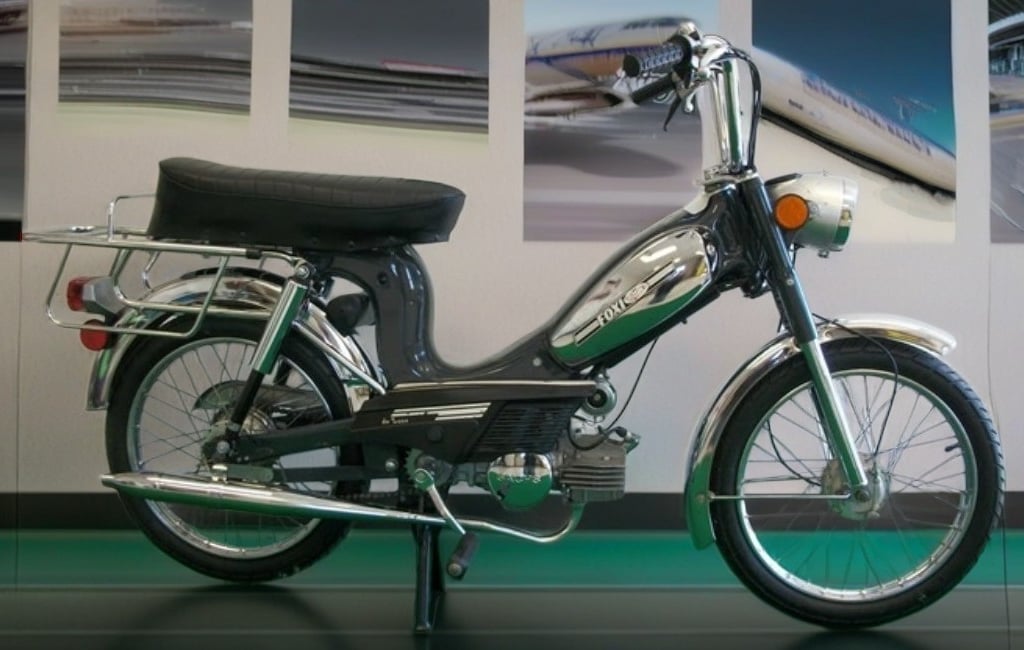Sparta-Foxi-Moped: An Emblem of Dutch Ingenuity and Moped Culture
The Sparta-Foxi-Moped is a Dutch moped that became a cultural icon in the 1970s. This article explores the origins of Sparta and the rise of the Foxi moped, its journey to America, model highlights and variations, the mechanics of the moped, and its cultural impact and timeless legacy.
2/19/20244 min read


Sparta-Foxi-Moped: An Emblem of Dutch Ingenuity and Moped Culture
Introduction
An emblem of Dutch ingenuity and a significant footnote in the moped culture, the Sparta-Foxi-Moped is a story of innovation, endurance, and style. Sparta began as a humble bicycle manufacturer and evolved into an iconic moped producer whose designs have stood the test of time. Their mopeds, especially the Foxi, became a cultural icon in the 1970s America, symbolizing freedom and adventure for the youth of the time. This article takes a closer look at Sparta's journey, the Foxi's development, technical specifications, and the cultural impact that these two-wheeled wonders made on both sides of the Atlantic.
The Origins of Sparta and the Rise of Foxi Mopeds
The Sparta factory, initially named Verbeek & Schakel, was established in Apeldoorn, Holland, in 1917. It soon became known as Sparta, embarking on a journey that would carve its name into the annals of motoring history. In 1931, their venture into motor-powered bicycles began, setting the foundation for a prosperous future in moped manufacturing.
The post-WWII era saw a surge in moped production as Sparta introduced models equipped with 74cc and 98cc Sachs engines, catering to delivery services and individual motorists alike. The company's golden era peaked in 1965, with a workforce of 380 producing a staggering 47,000 units. However, following the 1975 helmet law in The Netherlands, the moped industry faced a decline. Despite fluctuations in the market, Sparta's dedication to design and innovation never faltered, leading to the creation of its most renowned model: the Foxi moped, which would go on to become a classic emblem of the 1970s.
The Foxi Moped's Journey to America
The journey of Sparta mopeds across the Atlantic to America is a notable chapter in the company's history. In 1976, Sparta mopeds were introduced to the U.S. market under the Foxi brand, a name exclusive to this new audience. United Mopeds was the distributor that facilitated this transatlantic adventure, broadening the horizon for Sparta's exquisite designs.
The Foxi brand became synonymous with quality Dutch engineering and garnered significant attention from American moped enthusiasts. The integration of the Foxi moped into the U.S. market was a strategic move that not only expanded Sparta's global reach, but also etched its brand into the memories of American riders, many of whom cherish their classic mopeds to this day.
Model Highlights and Variations
Sparta's diverse moped lineup catered to a range of preferences and needs. Among them, models like the Foxi GT Sport and the Foxi Deluxe Automatik stood out for their distinctive design and reliable performance. The Sparta Buddy and Sparta De Luxe were also part of the impressive range imported and distributed by United Mopeds.
The design of these mopeds traced back to Sparta's legacy models of the 1950s, showcasing an evolution that mirrored the brand's commitment to innovation. For instance, the Foxi GT Sport boasted a step-through, stamped steel frame joined by bolts, known for its simplicity and ease of use. The evolution of Sparta's mopeds over the years epitomizes their dedication to combining aesthetic appeal with functional excellence.
The Mechanics of Sparta-Foxi Mopeds
The mechanics of Sparta-Foxi mopeds hail from an era of mechanical simplicity and reliability. Their heart—the Sachs 504/1 A engine—was a 47cc, 1-speed wonder that drove these vehicles with a combination of grace and gusto. Uniquely designed with Bosch or Motoplat electronics and 16" spoked LeuLeu wheels, these engines stood out for their double chain mechanism, separating the pedal and drive functions.
These mopeds were not only capable of zipping through city streets but also cruising country lanes with ease. The "30mph" models were especially coveted for their Bing 85/12/101A carburetors and expansive header pipes, allowing for a deceptively swift ride. Owners of the Foxi models relished in the moped's mechanical flair—its one-piece cylinder design contributed to its legendary durability and required dedicated maintenance to keep it in prime condition.
The Cultural Impact and Timeless Legacy
The Sparta-Foxi mopeds resonated deeply with the carefree spirit of the 1970s American culture. They were not just modes of transportation but were also emblems of individuality and freedom. During a time of social change, these mopeds offered an escape to the youth, a way to explore and express themselves.
Today, the collectors' community treasures these vintage mopeds, restoring and preserving them as relics of a golden age. The resurgence of moped interest, often referred to as the moped revival, speaks volumes about the lasting appeal of the Foxi. Enthusiasts gather, sharing stories and tips, bridging generations through a shared passion for these timeless two-wheel machines. The Sparta-Foxi moped isn't just a piece of history; it's a vibrant part of a living culture that appreciates simplicity, design, and the joy of riding.
Conclusion
In conclusion, the Sparta-Foxi-Mopeds represent a remarkable chapter in the annals of two-wheeled transportation. From their dutiful beginnings in post-war Europe to their iconic status in the streets of 1970s America, these mopeds have journeyed through time to become symbols of resilience and nostalgia.
The Sparta-Foxi brand encapsulates an era where simplicity and functionality were paramount, serving as a testament to Dutch craftsmanship and ingenuity. As collectors and enthusiasts continue to cherish these vintage vehicles, the Sparta-Foxi mopeds remain not only a cherished piece of personal memories but also a significant historical and cultural artifact in the world of motorized transport.
